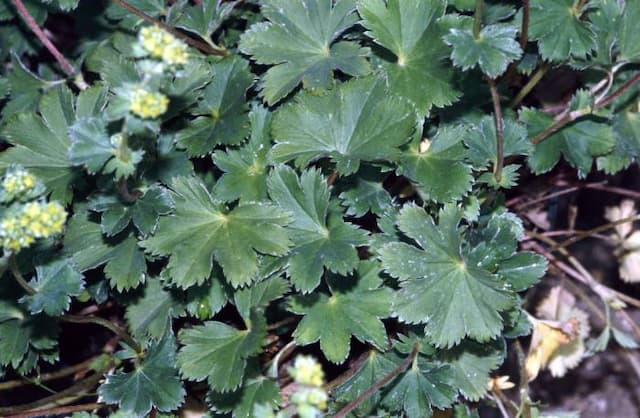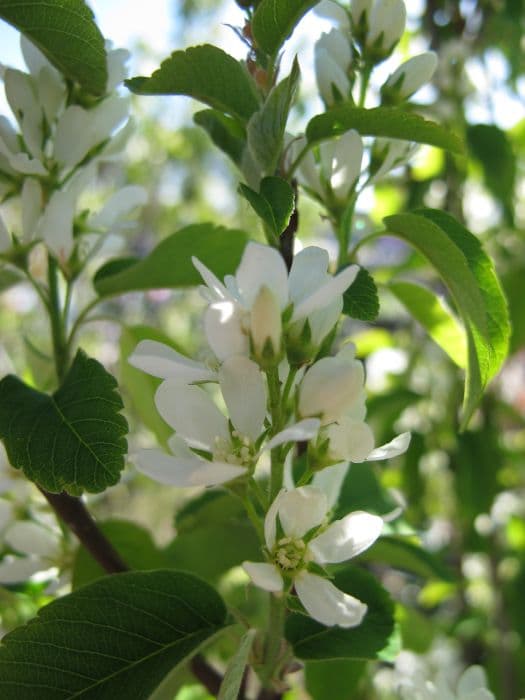Serviceberry Amelanchier canadensis (L.) Medik.

ABOUT
Amelanchier canadensis, commonly known as serviceberry, is a deciduous plant that is particularly notable for its seasonal transformations and decorative features. During spring, serviceberry is adorned with an impressive display of white flowers that emerge just before the foliage. The flowers are small and star-shaped, forming in clusters that provide a delightful contrast against the emerging leaves. As the plant progresses into the summer season, the leaves mature into a deep green shade, providing a lush backdrop for the developing fruit. The fruit, which resembles small berries, starts out as a vibrant red and gradually ripens to a deep, dark purple or almost black color. These berries are much appreciated by wildlife and can even be used in jams and pies. In autumn, the serviceberry's foliage undergoes another dramatic change, shifting to striking colors that can range from yellow to orange and red, giving it a fiery appearance that stands out in the landscape. The plant's bark, although not as flashy as its flowers or foliage, provides year-round interest. The bark is grey and can become slightly rough with age, sometimes displaying vertical stripes that add texture to the winter garden. With its captivating seasonal progression and decorative features, the serviceberry is well-loved by gardeners who value year-round interest in their landscaping.
About this plant
 Names
NamesFamily
Rosaceae.
Synonyms
Canadian Serviceberry, Shadblow, Shadbush, Juneberry, Serviceberry, Sugarplum, Indian Pear, May Cherry, Shadwood, Shadblow Serviceberry, Downy Serviceberry, Eastern Shadbush, Swamp Sugar Pear, Chuckle Pear, Currant-tree, Thicket Serviceberry.
Common names
Amelanchier intermedia Spach, Amelanchier oblongifolia (Torr. & A. Gray) M. Roem., Amelanchier ovalis Medik., Crataegus amelanchier L., Mespilus amelanchier L., Pyrus amelanchier (L.) L. f.
 Toxicity
ToxicityTo humans
The Serviceberry is generally considered non-toxic to humans. In fact, the berries of the Serviceberry are edible and can be consumed fresh or used in cooking. There are no well-documented cases of toxicity from eating the berries or any other part of the Amelanchier canadensis plant. However, like with any plant material, individual allergies may occur, so if someone has a known sensitivity to other fruits or plants in the Rosaceae family, they should approach Serviceberry with caution.
To pets
Serviceberry is not known to be toxic to pets. The fruit of the Amelanchier canadensis is also eaten by wildlife and is safe for dogs and cats to consume. There are no documented symptoms of poisoning from pets ingesting Serviceberry. However, ingestion of large amounts of the berries could potentially lead to gastrointestinal upset, such as diarrhea or vomiting, which is common with the consumption of large quantities of any type of fruit. Owners should always monitor their pets when introducing new foods into their diet and consult a veterinarian if any adverse reactions are observed.
 Characteristics
CharacteristicsLife cycle
Perennials
Foliage type
Deciduous
Color of leaves
Green
Flower color
White
Height
15-25 feet (4.6-7.6 meters)
Spread
15-25 feet (4.6-7.6 meters)
Plant type
Tree
Hardiness zones
4-8
Native area
North America
Benefits
 General Benefits
General Benefits- Edible Fruit: The berries ("Juneberries" or "serviceberries") are sweet and edible, suitable for fresh eating, jams, jellies, and pies.
- Wildlife Habitat: Provides food and habitat for birds, butterflies, and various pollinators which feed on the nectar, fruit, and insects attracted to the tree.
- Landscape Aesthetics: Adds ornamental value to landscapes with its showy white flowers in spring, medium green foliage in summer, and vibrant fall colors ranging from yellow to red.
- Erosion Control: This plant's root system helps to stabilize soil and control erosion, especially useful on slopes and in riparian zones.
- Low Maintenance: Once established, it requires relatively little care, making it a good choice for low-maintenance gardening and natural landscaping.
- Wildlife-Friendly: Its structure provides nesting sites and cover for birds and small mammals.
- Seasonal Interest: Offers year-round visual interest with its seasonal changes in foliage, flowers, and fruit.
- Native Plant Landscaping: As a North American native plant, it supports local ecosystems and can integrate well into native plant gardens.
 Medical Properties
Medical Properties- Antidiarrheal: Amelanchier canadensis, commonly known as Shadbush or Serviceberry, has been traditionally used to treat diarrhea.
- Astringent: The bark of the Serviceberry has astringent properties and has been used in folk medicine.
- Antiseptic: Serviceberry plants have been used for their antiseptic qualities in traditional remedies.
 Air-purifying Qualities
Air-purifying QualitiesThis plant is not specifically known for air purifying qualities.
 Other Uses
Other Uses- Serviceberry trees can be utilized in woodworking to create small decorative items due to their hard, dense wood.
- Landscape architects often plant Serviceberry trees for their ornamental value, especially for their showy white flowers in spring.
- The berries of Serviceberry are used to make naturally-dyed fabrics, giving them a soft, bluish-purple hue.
- Serviceberry branches can be used in floral arrangements and wreaths, particularly when they are in bloom.
- Culinary enthusiasts sometimes use Serviceberry blossoms as edible decorations for cakes and desserts.
- Photographers and painters often use Serviceberry trees as subjects for art due to their picturesque qualities.
- Bees keepers sometimes plant Serviceberry close to apiaries as their flowers are a valuable source of nectar for honey production.
- Bird watchers may plant Serviceberry in their yards to attract and observe a variety of bird species that feed on the fruit.
- The autumn leaves of Serviceberry, with their vibrant red and orange tones, are collected for crafts, such as leaf pressing or autumnal displays.
- Serviceberry wood chips are sometimes used in smoking food to impart a sweet, fruity flavor to meats and other dishes.
Interesting Facts
 Feng Shui
Feng ShuiThe Serviceberry is not used in Feng Shui practice.
 Zodiac Sign Compitability
Zodiac Sign CompitabilityThe Serviceberry is not used in astrology practice.
 Plant Symbolism
Plant Symbolism- Renewal: Amelanchier canadensis, commonly known as Serviceberry, is one of the early bloomers in spring, symbolizing new beginnings and the renewal of life.
- Hope: The white blossoms of Serviceberry signify hope and the assurance that after every winter comes spring, reflecting optimism for the future.
- Native American Heritage: Serviceberry has strong ties to Native American culture and symbolizes the plant's historical utility and reverence in indigenous traditions.
- Provision: As a plant that provides edible berries, Serviceberry stands for sustenance and the provision of necessities.
- Passage of Time: The changing seasons marked by the flowering and fruiting of Serviceberry represent the passage of time and life's impermanent nature.
 Water
WaterServiceberry requires moderate watering, especially during its first growing season to establish a deep root system. Water this plant with about 1 to 1.5 gallons of water per week during the dry season. Decrease watering in cooler months, but do not let the soil dry out completely. During drought conditions, increase the frequency to twice a week. Ensure that the water penetrates deeply into the soil rather than just wetting the surface.
 Light
LightServiceberry flourishes best in full sun to partial shade. It thrives when planted in a spot that receives at least six hours of direct sunlight daily. However, it can also tolerate lower light conditions, making it versatile for various garden placements.
 Temperature
TemperatureServiceberry is a hardy plant that can withstand a range of temperatures, surviving minimum winters temperatures down to around -40 degrees Fahrenheit. The ideal growth temperature range is between 60 to 75 degrees Fahrenheit. It is less tolerant of extreme heat, especially if accompanied by drought conditions.
 Pruning
PruningPruning serviceberry is essential to maintain its shape, remove any dead or diseased wood, and promote healthier growth. Prune in late winter or early spring before new growth starts, trimming back to maintain size and structure. Occasional thinning of the branches may be needed to ensure sunlight reaches the interior of the canopy.
 Cleaning
CleaningAs needed
 Soil
SoilServiceberry prefers a well-draining, loamy soil with a slightly acidic to neutral pH of 6.0-7.5. A mix rich in organic matter is ideal, such as a blend of loam, compost, and peat with some perlite for improved aeration.
 Repotting
RepottingServiceberry trees, being primarily outdoor plants, do not usually require repotting. They are typically planted directly in the ground and only transplanted if necessary for landscaping reasons.
 Humidity & Misting
Humidity & MistingServiceberry plants are adaptable to a wide range of humidity levels and do not require specific humidity conditions. They thrive in outdoor environments where humidity naturally fluctuates.
 Suitable locations
Suitable locationsIndoor
Growing Serviceberry indoors is not recommended due to its size.
Outdoor
Full sun to part shade, well-draining soil, and regular watering.
Hardiness zone
4-9 USDA
 Life cycle
Life cycleThe life of Amelanchier canadensis, commonly known as the Canadian serviceberry, begins with germination, where seeds typically require stratification to break dormancy and sprout. Upon germination, the seedling stage follows, with growth into a young sapling featuring characteristic simple oval leaves. Juvenile growth continues as the plant develops a woody stem and branches, eventually reaching maturity where it can produce its own flowers—a white, star-shaped bloom that appears in early spring. After pollination, these flowers develop into small purplish-black berries by mid-summer, which are consumed by wildlife, aiding in seed dispersal. As a mature plant, it can reach up to 20 feet tall and will continue to grow and produce flowers and fruit annually, often experiencing a vibrant fall color change in leaves. The Canadian serviceberry can live several decades, and with age, it can form clonal colonies through root suckering, expanding its presence in an area.
 Propogation
PropogationPropogation time
Spring to Summer
Propogation: The most popular method of propagating Amelanchier canadensis, commonly known as Serviceberry or Shadbush, is by seed. Seed collection occurs in summer after the fruit has ripened, typically from June to July. Once collected, the seeds require cold stratification for about 3 to 4 months at temperatures around 34-40 degrees Fahrenheit (1-4 degrees Celsius) to overcome dormancy. This simulates the natural winter conditions the seeds would experience in the wild. After stratification, the seeds can be sown in well-prepared soil in spring. To aid germination, sowing the seeds about 1/4 inch (~6 mm) deep in a mixture of sand and potting soil is often recommended. Seedlings generally require a couple of years of growth before they are strong enough to be planted out in their permanent positions.









